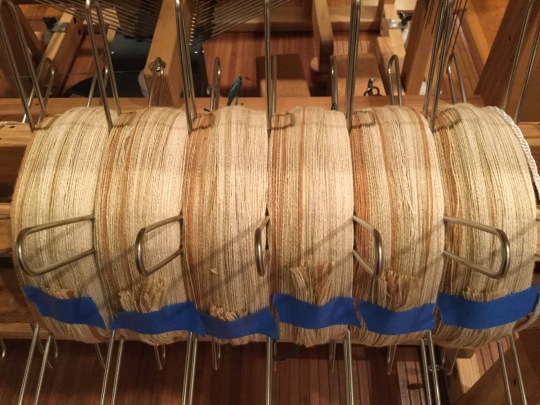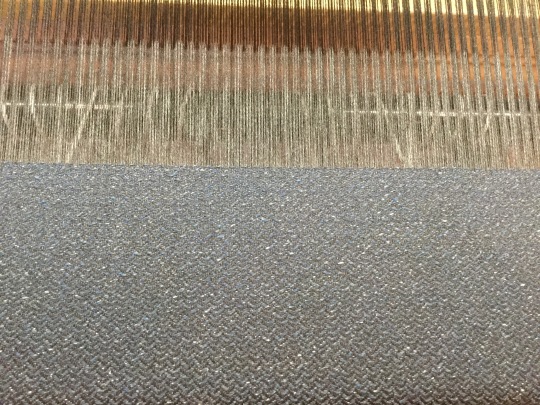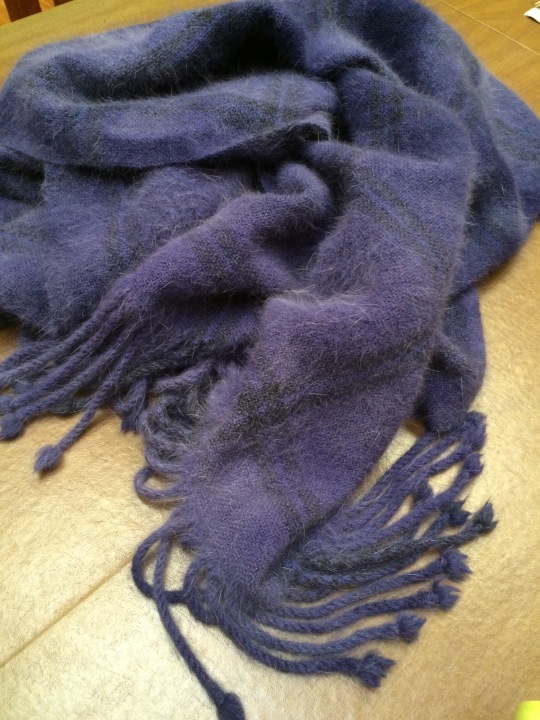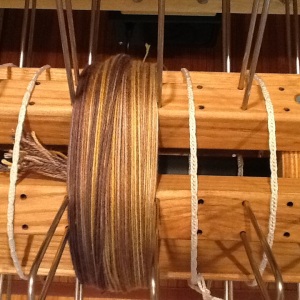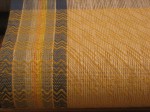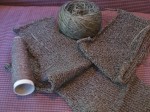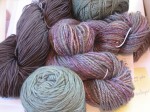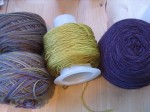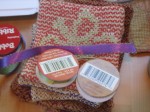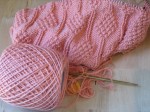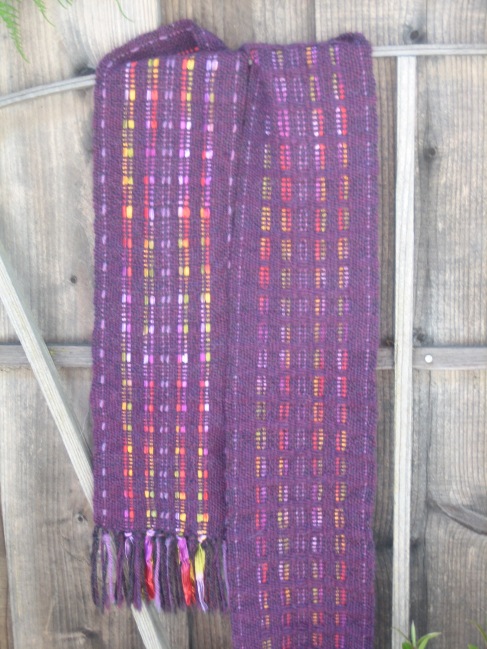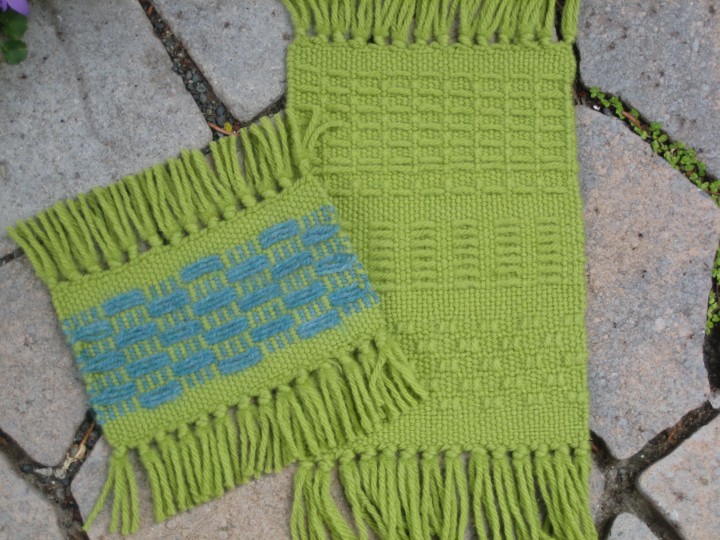Its a new year, a new start or renewal of works in progress and time for weaving.
Here we go again
Knitting Gauge…….
Here is the handout from the class I teach on knitting gauge. If it is useful to you, please feel free to use it for your personal use as well as share and learn from it!
All About Gauge
What is gauge and why does it matter?
Gauge is the number of stitches and rows in a square inch of knitting. If you are following a pattern it helps determine, along with the number of stitches you cast on, how big or small your finished product will be.
When you don’t get the gauge the pattern calls for with the specified yarn and needle size try:
1. Change the needle size. If you have too few stitches, your stitches are too big and you need to try a smaller needle size to make smaller stitches. If you have too many stitches, your stitches are too small, they need to be bigger so try a larger needle size. The brand and kind (bamboo, stainless steel, exotic woods) of needle can also affect gauge.
2. Change the yarn. If you have too few stitches maybe your yarn is too thick so you could try a thinner yarn. If you have too many stitches, you could try a thicker yarn. Generally, it is preferable to substitute yarns with the same properties as the original yarn. For example if the pattern uses a stretchy wool yarn, substitute another stretchy wool yarn. The fiber properties affect how the item will fit, wear and drape.
3. Change the pattern. If you like the way the knitted fabric feels and drapes with the yarn and the needles you have chosen and you do not want to change them then you can change the pattern gauge. You can recalculate the number of stitches to cast on for your pattern based on the gauge of your fabric. Sometimes you may find that either a size larger or a size smaller in the pattern will give you the finished size you want.
Just because you can get pattern gauge with a substituted yarn, doesn’t mean it will make a nice garment. Gauge is important but so is how the fabric feels!
The gauge and needle size suggested on the yarn label is a place to start. However, since knitting styles vary you may need to use a different needle size to get the suggested gauge.
When measuring a gauge swatch, treat your swatch the way you will treat your finished product. For example, if you are going to wash and dry your item, do that to your swatch before measuring.
Tips on Changing a Pattern
1. Look at the schematic of the pattern in inches, or calculate the number of inches based on the pattern gauge.
2. Multiply the number of inches by your stitches/per inch gauge to get the new number of stitches to cast on.
3. Adjust all shaping to your new gauge.
4. If the new gauge is significantly different than the pattern gauge you may need to account for row gauge. Generally measuring the piece in inches will work out fine.
Color Study
Equipment: 15″ wide rigid heddle loom and 10 dent rigid heddle.
Yarns; warp and weft: 10 skeins Handwerks So-Soft Sock, 80% superwash merino/10% cashmere/ 10% nylon, 435 yds/100 gram skein. Colors used are listed below in warping order.
Warp length: 3 yards, allowing for 12″ loom waste and 12″for fringe. Warp the loom with 14 ends of each color in the following order: Desert Sands, Peach Blush, Pyracantha, Heirloom Tomato, Lavender, Twilight Dance, Sage, Bodega Bay, Winged Teal and Bay Blues.
Tie the warp on, leaving 6″ for fringe at the beginning of your weaving. Spread the warp with 4 picks of a smooth fingering weight waste yarn. Begin weaving with weft yarns.
Weave a total of 80″ as measured on the loom, end with 4 picks of waste yarn, cut off leaving 6″ for fringe. Finish fringe by twisting or knotting. Wash by hand to lightly full and hand to dry.
Weaving Suggestions:
1. Weave 8″ of each color in the same order as the warp colors.
2. Weave 2″ of each color in warp color sequence and repeat 4 times.
3. Weave 2″ of each color in the warp color sequence then repeat the sequence but in reverse order. Repeat again.
4. Weave 2″ of each color in the warp color sequence and then experiment with color sequences and size of stripes, leaving enough warp to finish with 2″ of each color at the end. Use the Fibonacci series to design the size of stripes, playing with wide and narrow stripes next to each other, reversing the color order.
5. Play with color sequences to see what patterns can be created by varying color order. Notice how the stripes stand out as well as blend because of the value of the color, i.e. how light or dark they are. Look at the grey scale scan of the yarns used to see the value of the colors. Try weaving the colors from lightest to darkest or vice versa.
6. Try weaving a few picks of fingering weight yarns that are in the same color families as the warp yarns. For example, weave Tide Pools adjacent to Winged Teal, Violet Asters next to Bay Blues and Fir before Sage.
7. Experiment!
Here is a grey scale scan of the yarns I used:

And the finished scarf/wrap:

The New Kid
My new V-Series is now assembled and ready for its first warp! One section down and a few more to go for a scarf with a point twill threading. The warp is long enough to let me play and put the loom through its paces. I have a good feeling about the size and managability of this loom, here’s to hoping I can weave without shoulder issues (or too many issues!) 🙂
Filling Space
Lately, I’ve been thinking a lot about space. How to fill and leave space. There is space in my life, space in my studio, space on my shelves, space on the warp beam, space in cloth. There is a balance needed, the right amount of stuff but not too much, so it is pleasing, not too crowded, still functional and useful. Allowing space for inovation and inspiration.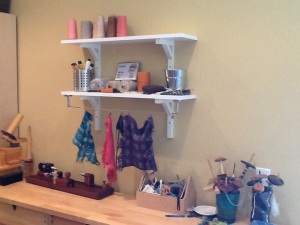
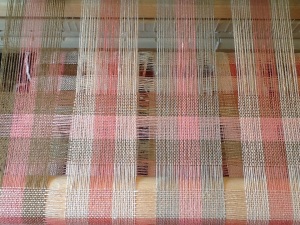
Spring Cleaning
Its time to make some changes. I’m slowly moving content and patterns from my website to this blog and to Ravelry. I’m focusing on wholesale yarn sales and getting back to more weaving explorations. So, this will be the place to watch in the future.
Reinvention
Dictionary.com says: To re·in·vent:
1.to invent again or anew, especially without knowing that the invention already exists.
2.to remake or make over, as in a different form: At 60, he reinvented himself as a volunteer. We have an opportunity to reinvent government.
3.to bring back; revive: to reinvent trust and accountability.
“Women’s lives are about redefinition”, excerpt paraphrased from Anna Quindlen’s book, Lots of Candles, Plenty of Cake. How does reinvention differ from redefinition? Maybe they are variations on the same idea or theme. It seems to me like it is about making something old anew.
Are we reinventing or inventing or creating or borrowing ideas from others or just doing what we do when we make things? Here is what I’m working on; I have all of this swirling around in my head, mixing together ideas, colors and techniques that I’ve tried and seen before. It pours out it in all these forms and somehow its related and makes sense.
More Pick-Up
I had so much fun with my pick-up samples on the rigid heddle loom I wove off a scarf. I designed this simple pattern to pick-up the ribbon yarns in the warp and let them show more prominently on the surface of the scarf. I also picked up some contrasting yarns to complement the ribbon. I’m on a roll.. as I’m sure I’ll do more of this kind of structure. I especially like playing with color and texture. (Class schedule is on my website if you are local and interested.)
Picking Up Pick-Up
I’m playing with pick-up patterns on the rigid heddle (RH) loom in preparation for a class I’m teaching at Uncommon Threads. Its giving me a break from threading the big 24H dobby loom. This is a fun and easy way to get patterns on a simple loom. I’m struck by the comparison of simple loom complex patterns vs. complex loom simple patterns…..It took about the same amount of time to warp up the RH loom, weave 3 samples of different pick up patterns, and wash the samples as wind a 20 yard warp on the back beam of the dobby loom, and organize the heddles. OK, I know that the end product is really different as I’m going to weave a bunch of towels on the dobby and just a few samples on the RH but its kind of interesting to compare. Sampling on the RH is very quick and interesting if you want to try out something new. With pick-up, the patterns approximate what would take you much longer to achieve on a dobby loom.
Why do I dread tax day? It comes every year and it’s not really a suprise, we owe money. It happens….sigh. Oh well, I’ve paid my taxes and now I’m looking forward to this weekend when I’ll be at The Golden Fleece, 317 Potrero St, Santa Cruz, CA., Saturday, April 21 at 1pm. Jocelyn, aka Fiberdev, will be there with patterns and samples. I’ll bring the yarn! Its the shop owner’s one year anniversary. Now that’s something to celebrate!


